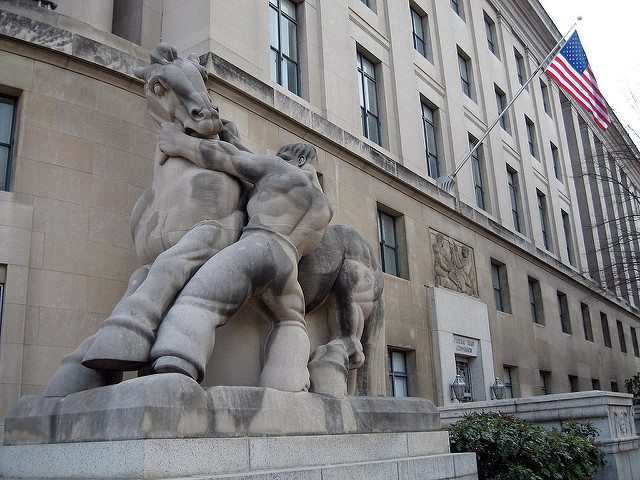
Enforcement decisions are oft-overlooked, yet such decisions merit heightened scrutiny if regulatory capture is to be reined in.
“Regulatory capture” sounds like something totally at odds with the rule of law. It implies that officials favor specially placed interests.
When seeking to identify and understand regulatory capture, however, the important questions are who is doing the capturing, and what sort of decisions flow from the conquest. These inquiries turn out to be more complicated than much of the commentary about regulatory capture suggests.
This is especially true for an aspect of administrative decisionmaking that is less often associated with the notion of capture: enforcement. Enforcement is a major component of administrative action. It takes place in the context of formal prosecution—a setting that rightly is counted as part of the administrative process, subject to the same sorts of pressures and practical problems that affect a broad array of executive functions.
Enforcement also takes place through actions by agencies that are primarily associated with licensing, such as the Federal Communications Commission (FCC); after all, a licensing system has to be backed up with actions that implement the rules for getting licensed and enforce the conduct required of, or prohibited for, licensees. Television and radio licenses, for example, have been subject to non-renewal—or, in extreme cases, revocation—for violation of FCC rules.
Enforcement takes place as well in the context of agencies’ regulating, adjudicating, and enforcing rules that are designed to make businesses more fair, effective, or protective of consumer interests (such as the U.S. Securities and Exchange Commission and the Federal Trade Commission).
In any of these contexts, enforcement officials have to balance the costs of an action against its expected benefit. That benefit might be evaluated in terms of its impact on public interests. Or it might be evaluated in terms of the narrower interests of the individual official or agency.
Every enforcement portfolio comprehends a multitude of discrete decisions: bringing an enforcement action or deciding not to bring an action, putting extra resources into investigating a target or pursuing a complaint, adding charges designed to increase pressure on the enforcement target or compromising or dropping an action. Each of these decisions is to some degree discretionary, necessarily guided by something other than black letter law.
Particular enforcement actions can be affected by chance (what cases are underway when a decision has to be made, how one case fits with others, what resources are available in the budget at the time). They may be affected as well by the particular lens through which priorities and prospects are seen, shaping choices for better or worse.
The “regulatory capture” thesis is that in exercising this discretion, officials too often take steps that benefit well-placed entities and individuals. For example, the frequently voiced complaint that no Wall Street executive or bank official has gone to jail for conduct linked to the economic recession of 2008 to 2010, is commonly joined with the assertion that this shows that these business interests have outsized influence over government officials.
No doubt, some enforcement decisions respond to concerns about what someone’s reaction will be. But the someone whose reaction matters is not always—maybe not even most often—the regulated entity or industry. For one thing, industries are not monolithic. Regulated industries may dislike enforcement, but industries frequently are divided, with some firms pushing hard (and others secretly hoping) for a competitor to be pursued.
Other distortions could loom larger than industry capture. Enforcers can gain favor for bringing actions, and a “crusading prosecutor” often has a springboard to higher office. That is one reason that the National Association of Attorneys General (NAAG) has been dubbed the “National Association of Aspiring Governors.” For certain government officials, prospects for future employment in a regulated industry may matter less than impressing voters, gaining notoriety with other potential employers, securing support from agency staff, or doing what fits the official’s own ideals. Further, the notion of “distortion” itself, which is essential to the capture thesis, presumes a neutral baseline of what sort of enforcement profile is right.
More mundane considerations also can govern. Enforcers respond to the perceived probability of success: why waste resources on enforcement actions that are not likely to prevail? Doing so can deplete scarce resources and embolden others to buck enforcers’ efforts to secure compliance with their view of the law. Similarly, it may not seem worthwhile to invest in cases that would add little punch to already-successful enforcement initiatives.
Attention to enforcement decisions, however, is extraordinarily important in light of the sheer volume of rules and regulations that can be enforced. Congressionally enacted laws today are codified in over 50 volumes of the the United States Code, spread over more than 20,000 pages. Administrative rules—adopted by agencies rather than by Congress—occupy nearly 180,000 pages. Thousands of rules establish prohibitions or requirements that almost no one would expect; punishment for violating rules rarely has to be based on conduct that an ordinary person would think of as wrong, nor does it require proof of knowledge of the rule, or even establishing unreasonable ignorance of the rule. This makes every person, business, and enterprise a potential enforcement target, giving huge discretionary power to the officials who are able to choose when and how to seek punishment for violations of the rules.
Enforcement decisions that appear questionable might reflect regulatory capture, but that is neither obvious nor easily encapsulated in a simple story line of who is doing the capturing. Yet, in a system that, intentionally or not, confers enormous discretionary power on enforcers, any potential source of bias merits scrutiny. Whether enforcement decisions are products of reasoned choice, mere chance, or administrative chicanery, scholars, businesses, politicians, and citizens should look for ways to limit enforcers’ discretion. Paring back the range and complexity of the rules to be enforced is an excellent place to start.
This essay is part of The Regulatory Review’s sixteen-part series, Rooting Out Regulatory Capture.




